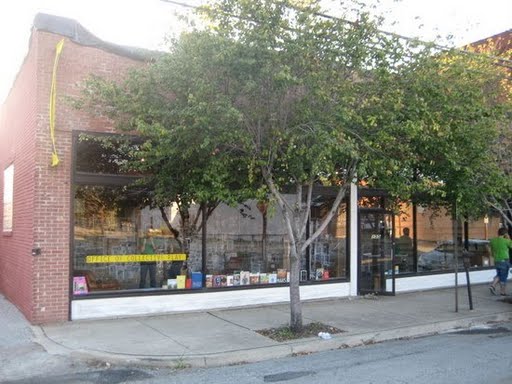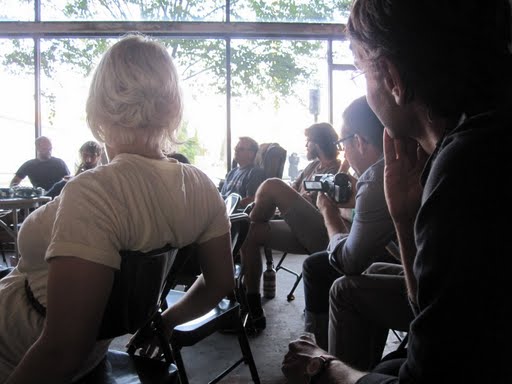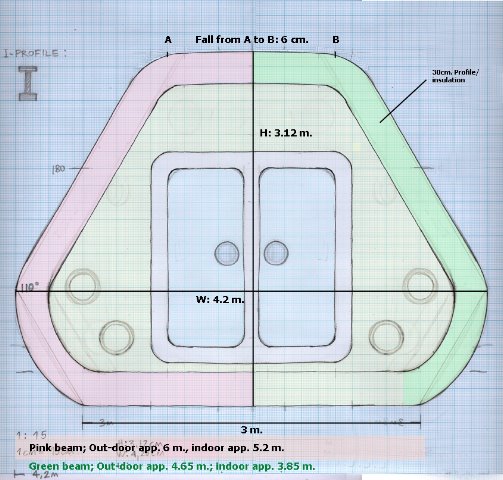
Last Thursday, the new exhibition “Descent to Revolution” organized by Columbus College of Art & Design’s Bureau for Open Culture opened in Columbus, Ohio. Taking place around the city and at a temporary location in a former storefront downtown, “Descent to Revolution” will host residencies by five artist collectives and collaboratives over the course of the next three months. These groups will take up projects that engage and respond to the city of Columbus. The first resident is Portland-based collective Red76, followed by Claire Fontaine, Learning Site, REINIGUNGSGESELLSCHAFT, and Tercerunquinto. “Descent to Revolution” curator and the director of exhibitions for the Bureau for Open Culture James Voorhies took a moment to answer a few questions about the show. You can follow the exhibition as it develops through the "Descent to Revolution" blog, here. - Ceci Moss
It seems like the multidisciplinary and fluid nature of the exhibitory framework for "Descent to Revolution" is a natural extension of the Bureau for Open Culture's activities and ethos. I am wondering if you can speak more about the Bureau for Open Culture itself and how the space came into being.
Yes. "Descent to Revolution" is, in a way, a culmination of some of the underlying ideas of what we're doing at the Bureau for Open Culture. The Bureau for Open Culture was created as a way to give shape to the exhibition program I've been operating since 2006. Many of the projects we've organized have taken place outside of the gallery or had components outside of it and often involved participants from diverse disciplines and locations like libraries, non-profit music venues, city-owned sites, empty storefronts and other area universities. Since the gallery wasn't the only locus of activity, I had to find a way to define this discursive programming. I think the name Bureau of Open Culture describes it in a nice way. On one hand, it kind of refers to a history of the curator as caretaker, maintainer of order, a bureaucrat. That concept is connected to a curatorial practice that questions limits of exhibition spaces and contexts, embraces different disciplines, and expands the exhibition model to a series of events. So, I hope we open up new trajectories with the projects we produce. In a sense, it often feels like things are left open-ended without obsessing over definite conclusions. But, I believe the Bureau for Open Culture is also responding to the exciting and innovative activity happening in contemporary art right now in terms of artists transgressing different disciplines, coming from science, geography, philosophy, astronomy, education, engineering. They are removing emphasis on objects and a singular institutional site for experiencing art just like the five collectives participating in “Descent to Revolution.”
I also have a strong interest in exhibition as education, not in the traditional sense of an education department. We are a super small organization. But, we make lots of printed materials for each project and have informal talks and workshops. Events are always free and printed materials are always distributed widely for free or for suggested donations. The website also has everything downloadable. Catalogues, cards and bookmarks, for instance, give context to the concepts and I hope provide different points of entry for visitors. By this I mean the projects do come from "high concept" themes but I try to distill ideas in a way that allows everyone to get something out of each exhibition. But, of course, visitors need to be willing to take a step in. And, after that happens, that's where the idea of trajectories comes in.


The title of the exhibition is "Descent to Revolution." Would you argue that the five collectives/collaboratives involved - Claire Fontaine, Learning Site, Red76, REINIGUNGSGESELLSCHAFT, and Tercerunquinto - genuinely aspire to some variety of revolution? Do you foresee any of these groups using their projects to redefine or even contest the term "revolution"?
Each of the five collectives and collaboratives do aspire to forms of revolution, some more closely related to what we traditionally consider revolution and others going at it with a more subtle but no less significant approach. I think the thing in this context is to understand what the exhibition is referring to as revolution. My interest in all these collectives’ work is based on their extraordinary abilities to make materials, situations, objects, texts, actions and ideas that tease out, bring to the surface, knowledge, sometimes forgotten or overlooked. Then, they make that knowledge relevant to our contemporary life. And, it's through this surfacing of information about our society in general and about the city of Columbus, in this case, with the exhibition that they stimulate conversations about current conditions and what can change. So, over time, with the dispersal of information and access to knowledge, revolution is an incremental process but no less effective. The Situationist Guy Debord believed cultural behavior could change this way, over time, and I love what Michael Hardt writes about Thomas Jefferson’s belief that the Constitution should be rewritten about every twenty years, or with each generation, to keep it always relevant. Instead, it’s become an institution with an incredibly rigid and outdated set of confines.
For the duration of "Descent to Revolution" the Bureau for Open Culture's regular space the Canzani Center Gallery will exist only as an information center for artist's projects, but otherwise will remain empty. Could you discuss where some of the artist's projects will take place in the city of Columbus and how they anticipate to make use of these locations?
Red76 is first up. They are here for about one month and will be building a schoolhouse out of repurposed materials and skills in a parking lot on CCAD's campus. The schoolhouse is called Anywhere/Anyplace Academy and is part of Surplus Seminar, which is a number of activities, print material and actions that look at how we learn from one another and how to repurpose excess skill and material to teach one another. Sam Gould made a site visit in February and the project developed from there. Parking lots are a big theme with a couple of the participants. There are a lot of parking lots in Columbus. So, Red76 will not only make a schoolhouse together with community and with CCAD students over the course of their residency but the very act of situating it in a parking lot will be noticed by those trying to find a space to park.
Rikke Luther and Cecilia Wendt of Learning Site visited in June to check out Columbus. They stayed in the artist house on CCAD's campus, which is a rather strange but wonderful house made of two small 19th-century brick structures that are landmarked. But, the house is an island in the middle of a huge asphalt parking lot, kind of a piece of lost history floating in some postmodern abyss. Rikke and Cecilia are making what is called Audible Dwelling. It is a two-part dwelling. One half will be a site where visitors can walk into it and record a story, a private history. That audio will eventually be played from the other half, which is a habitable anechoic chamber and public loudspeaker. Along with Jaime Stapleton, Learning Site is writing a semi-fictional story about parking lots, retail collapse, and suburban sprawl, ideas that relate to Columbus. It will all be projected by loudspeaker into public space. The dwelling will eventually travel to Cambridge, England, and then a final site in Copenhagen. New audio from these sites will make it specific to location. It’s a big project. Learning Site spent a lot of time researching the urban history of Columbus. I learned so much about downtown Columbus when they visited. For instance, the same area today that has 3,000 residents once had 30,000 residents. Many of those sites of houses are now parking lots.

One of the aims of "Descent to Revolution" is to produce work in concert with the community. How are the artists in this exhibition publicizing their projects and inviting participants to get involved?
The Bureau for Open Culture is acting largely as the communication hub for getting out the word about the projects, events and actions. One component in the exhibition is an off-site, downtown space called Office of Collective Play. It will act as kind of headquarters and playground. A lot of activity will be take place in it and on CCAD’s campus. They are in walking distance from one another. So, we’ll be sending out regular email notices and canvassing the city with flyers about upcoming activities. Also, we will make major solicitation everywhere to get folks to participate in, for instance, a workshop with REINIGUNGSGESELLSCHAFT. Martin Keil and Henrik Mayer will organize a readymade revolution in the form of the revolution in East Germany in 1989. With this in mind, the workshop will draw in participants to make printed material that will be part of an organized procession in downtown Columbus. This will draw on that history in Germany (and the world) and it will also look at how revolution-for-hire is today part of a capitalist economic stream. And, in preparation for Claire Fontaine’s late October visit I am holding a weekly reading group that will read and talk about Jean-François Lyotard’s Libidinal Economy in association with the Autonomia Movement in Italy and war economy. Claire Fontaine’s residency will be focused on some of these ideas with a public talk and gathering. All of this information will be posted and constantly updated on the blog for “Descent to Revolution.” Right now, we have something like 35 events planned over the next two months along with the continual work that will be done while the collectives and collaboratives are here. It’s going to be incredibly fun and so valuable. I think we recently realized the strong sense of “descent” on Columbus by these artists will provide insightful perspectives on place; an outlook that only those who do not regularly live in a place can contribute.

